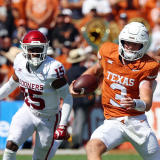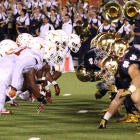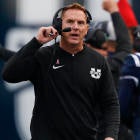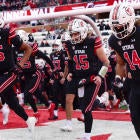In a sign of how truly lousy college football's opening week used to be for too long, Week 1 of the 2016 season is getting billed as a monster kickoff weekend. And rightfully so.
- No. 1 Alabama vs. No. 20 USC
- No. 3 Oklahoma vs. No. 15 Houston
- No. 4 Florida State vs. No. 11 Ole Miss
- No. 18 Georgia vs. No. 22 North Carolina
- No. 2 Clemson at Auburn
- No. 5 LSU vs. Wisconsin
- No. 10 Notre Dame at Texas
- No. 16 UCLA at Texas A&M
- Kansas State at No. 8 Stanford
That's a very compelling Week 1 schedule. To make this happen, TV networks negotiated the exposure, neutral-site venues wrote the checks, and the College Football Playoff Selection Committee allegedly emphasized strength of schedule. So, kudos to them for helping produce one of the strongest Week 1s ever.
But is it the best on paper as many are billing it to be? No, and it's not close.
Week 1 in 2016 is tied for the third-most AP Top 25 matchups to start a season over the past 40 years, according to research by CBS Sports. There are four such games this season, the most in Week 1 since 2009 also had four: Boise State-Oregon, BYU-Oklahoma, Alabama-Virginia Tech and Georgia-Oklahoma State. There was only one top 25 game to start 2015 (Alabama-Wisconsin), which marked the fewest since 2007.
But for those of you too young to remember, college football teams used to actually challenge themselves immediately. Shocking, I know. Powerhouses vs. directional schools didn't always litter Week 1. From 1996-2005, Week 1 featured 27 percent more top 25 games than from 2006-15.
Why? It's about incentives. The decline of top 25 games in Week 1 actually started earlier than 2006, but 2006 is an important year. That's when the NCAA permanently allowed a 12th permanent game in the regular season. Instead of scheduling difficult home-and-home games, most schools used the extra game to play a cupcake and guarantee a seventh or eighth home game.
Interestingly, 1998 produced an incredible eight Week 1 games that paired top 25 teams. That's easily the most over the past 40 years. It also happened to be the first year of the Bowl Championship Series, which used a formula to pair No. 1 vs. No. 2 for the national title.
Maybe coaches in 1998 thought the BCS would actually reward strength of schedule and allow flexibility from an early loss. Maybe their hands were tied due to game contracts made years in advance. Maybe they were so used to tough early games -- pre-1998 losses didn't hurt as much since bowl games were tied directly to conference contracts -- that coaches thought nothing of challenging themselves.
Whatever the reason, Week 1 was very compelling in 1998.
- No. 5 Michigan, a defending national champion and with Tom Brady at quarterback, lost to No. 22 Notre Dame.
- No. 8 Arizona State dropped a shootout to No. 18 Washington.
- No. 12 North Carolina got stunned by Miami (Ohio) on a last-second field goal, spoiling the coaching debut of Carl Torbush.
- No. 15 Colorado State went on the road and claimed its first win ever over a Big Ten team by upsetting No. 23 Michigan State as Nick Saban surprisingly benched his quarterback.
- No. 1 Ohio State easily won a road game at No. 11 West Virginia.
- No. 2 Florida State, the eventual national runner-up, rallied from a halftime deficit behind new quarterback Chris Weinke to beat No. 14 Texas A&M at the Kickoff Classic.
- No. 10 Tennessee, the eventual BCS champion, edged No. 17 Syracuse and Donovan McNabb in a wild game at the Carrier Dome with a controversial officiating call late.
But as the BCS era continued, schools soon realized there wasn't much incentive to face an early challenge. The BCS formula was heavily slanted toward poll voters who favored undefeated teams and lacked the will to reshuffle teams if a team didn't lose. Where a team started in the polls often dramatically helped where it finished.
Unless a team played in the SEC, it had virtually no mulligan in the BCS era once 12 games arrived. During the final eight years of the BCS, six of the eight teams that played for the national title with at least one loss came from the SEC.
Consider Oregon in 2011. The Ducks were ranked No. 3 in the preseason one year after barely losing to Auburn in the BCS Championship Game. They challenged themselves in Week 1 and lost to No. 4 LSU. Oregon finished with two losses and was fifth in the BCS standings, while LSU was No. 1. If Oregon had scheduled a Week 1 win instead of LSU, the Ducks could have made a very good argument that they deserved a championship game matchup vs. LSU instead of Alabama receiving a rematch.
Meanwhile, more universities kept adding football teams into the Football Bowl Subdivision. Theoretically, that meant a larger market for an elite team to schedule a mediocre to bad team. In 1998, there were 112 teams in football's highest division. In 2016, there are 128 teams.
But conference expansion has impacted that market. More teams in a conference equals fewer options to schedule nonconference opponents of a certain caliber. (That is, unless you're North Carolina and Wake Forest, which are ACC rivals that now rarely play each other. They scheduled a nonconference series for 2019 and 2021.)
Slowly, the mindset is changing to play more challenging games early. The CFP Selection Committee publicly emphasizes strength of schedule, so that's a factor schools are considering for better Week 1 games. But until we see the committee pick a playoff team with one more loss than someone left out, it's hard to say how much nonconference schedules are truly valued.
More likely, there are better Week 1 games for three other reasons.
1. Expanded postseason: It's basic math. When four teams reach the biggest postseason games instead of two, there's a better chance to absorb a mulligan and still make the playoff. Ohio State won the national championship in 2014 despite a Week 2 loss at home to Virginia Tech. Alabama won it all in 2015 despite a Week 3 loss at home to Ole Miss. There's more flexibility to get tested early (unless you're a Group of Five school, of course).
2. Financial considerations: Fans voted with their wallets and remote control that they want better games. Home attendance has declined for a number of years at many schools. Landing an attractive nonconference opponent can help with season ticket sales. Still, most of these quality Week 1 games are at neutral sites. Attractive neutral-site games often pay more than revenue from home games. Alabama gets $6.5 million for playing USC. ESPN plays matchmaker to find compelling games that help justify the network's exorbitant rights fees it's paying conferences.
3. Blind luck: In September 2014, Oklahoma scheduled games against Houston for 2016 and 2019. The Sooners sold it as a way to showcase themselves in one of the nation's largest markets. Ohio State was already on the Sooners' 2016 schedule as the big-name opponent for Week 3. Houston was coming off an 8-5 season, not a 13-1 record in 2015 with a bowl win over Florida State. To their credit, the Sooners didn't back out of Houston. Oklahoma-Houston, now with the backdrop of possible Big 12 expansion, is a rare example when scheduling a couple years in advance gives us a better matchup than initially expected.
There will be 14 games in this season's Week 1 pairing Power Five teams or a Power Five school against a ranked Group of Five opponent. That's double the Week 1 total from 2011 when counting the same schools then as they are configured today.
Over the past 10 years, Alabama and Georgia have played in the most Week 1 top 25 games (five each). Next are LSU (four), Boise State (four) and Clemson (three). More names will be added to this list in the future as Power Five teams play each other more often given stipulations by their conferences due to the CFP.
Look at some of the games for Week 1 of 2017: Alabama-Florida State, Michigan-Florida, UCLA-Texas A&M, LSU-BYU, Tennessee-Georgia Tech, West Virginia-Virginia Tech, Notre Dame-Temple and Texas-Maryland.
Now, there's no given what those games will look like a year from now. Some of the luster is off Week 1 games in 2016 since they were scheduled, such as Clemson-Auburn and UCLA-Texas A&M. No matter. Week 1 should be highly entertaining.
The start to college football in 2016 may not be the best ever on paper. But it's still awfully good.
Most Week 1 AP Top 25 games (since 1976)
| Year | Games | Matchups |
| 1998 | 8 | No. 15 Colorado State 23, No. 16 Michigan State 16 |
| No. 2 Florida State 23, No. 14 Texas A&M 14 | ||
| No. 16 Virginia 19, No. 25 Auburn 0 | ||
| No. 1 Ohio State 34, No. 11 West Virginia 17 | ||
| No. 13 Penn State 34, No. 21 Southern Miss 6 | ||
| No. 10 Tennessee 34, No. 17 Syracuse 33 | ||
| No. 18 Washington 42, No. 8 Arizona State 38 | ||
| No. 22 Notre Dame 36, No. 5 Michigan 20 | ||
| 1985 | 5 | No. 17 Florida State 17, No. 10 Nebraska 13 |
| No. 16 Oklahoma State 31, No. 12 Washington 17 | ||
| No. 19 Penn State 20, No. 7 Maryland 18 | ||
| No. 6 USC 20, No. 11 Illinois 10 | ||
| No. 20 UCLA 27, No. 8 BYU 24 | ||
| 1995 | 4 | No. 14 Michigan 18, No. 17 Virginia 17 |
| No. 12 Ohio State 38, No. 22 Boston College 6 | ||
| No. 14 Colorado 43, No. 21 Wisconsin 7 | ||
| No. 15 UCLA 31, No. 12 Miami 8 | ||
| 2009 | 4 | No. 14 Boise State 19, No. 16 Oregon 8 |
| No. 5 Alabama 34, No. 7 Virginia Tech 24 | ||
| No. 20 BYU 14, No. 3 Oklahoma 13 | ||
| No. 9 Oklahoma State 24, No. 13 Virginia 10 | ||
| 2016 | 4 | No. 1 Alabama vs. No. 20 USC |
| No. 3 Oklahoma vs. No. 15 Houston | ||
| No. 4 Florida State vs. No. 11 Ole Miss | ||
| No. 18 Georgia vs. No. 22 North Carolina |
Source: Sports-Reference.com
Note: College football used to have an abbreviated Week 1 schedule. For those years, this list counted Week 1 and Week 2 games pairing top-25 opponents as long as the matchup was the opener for both teams.
















